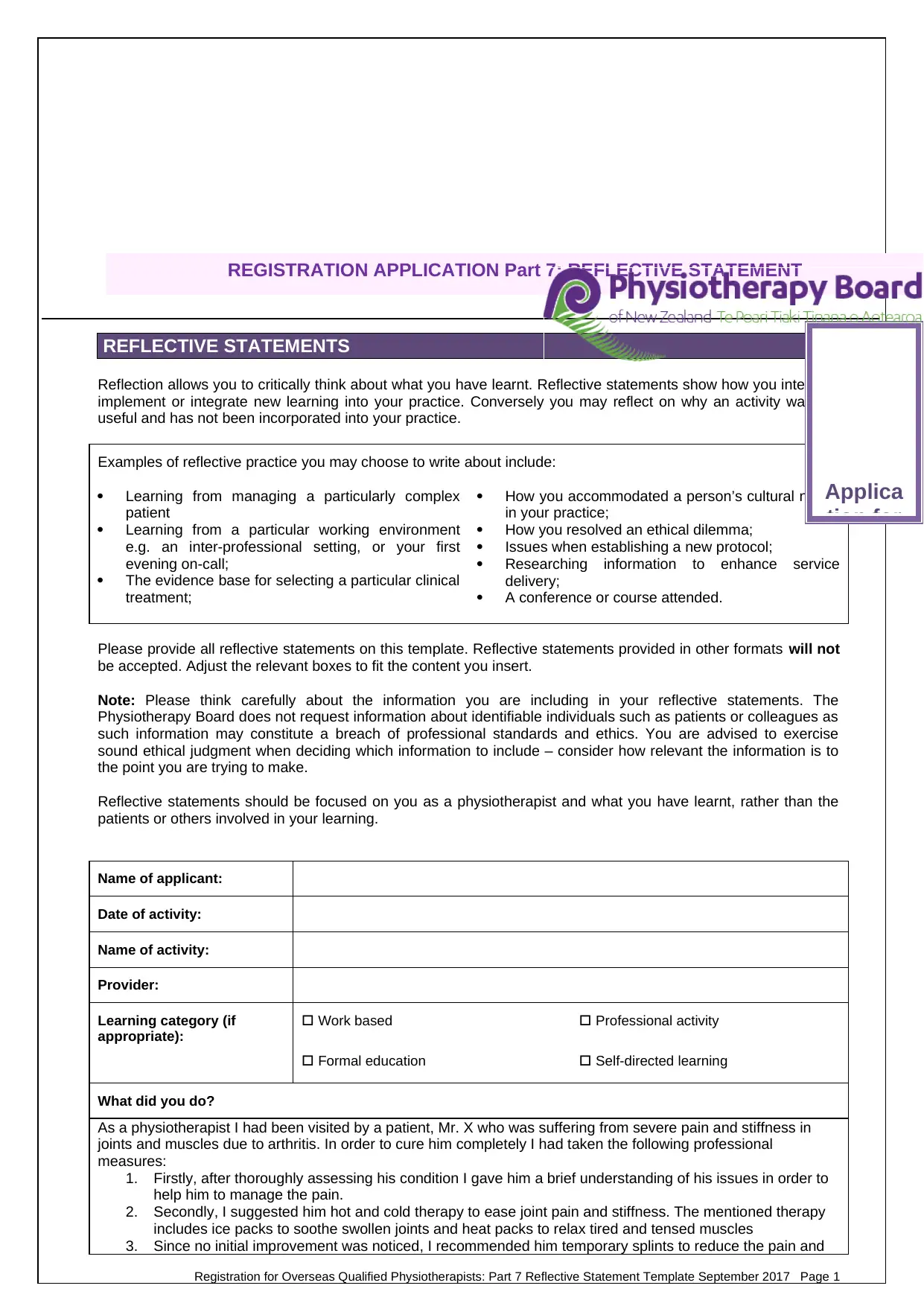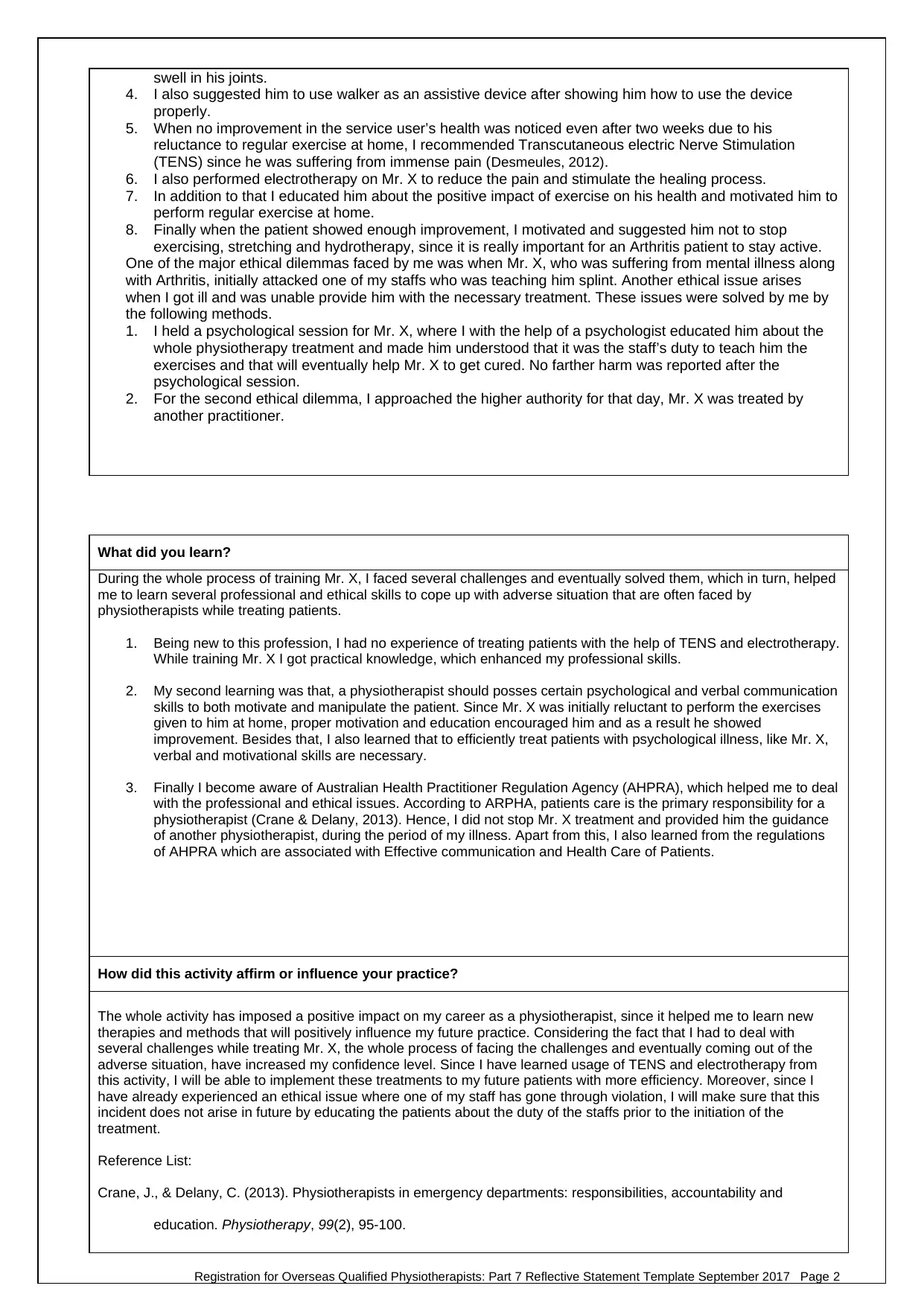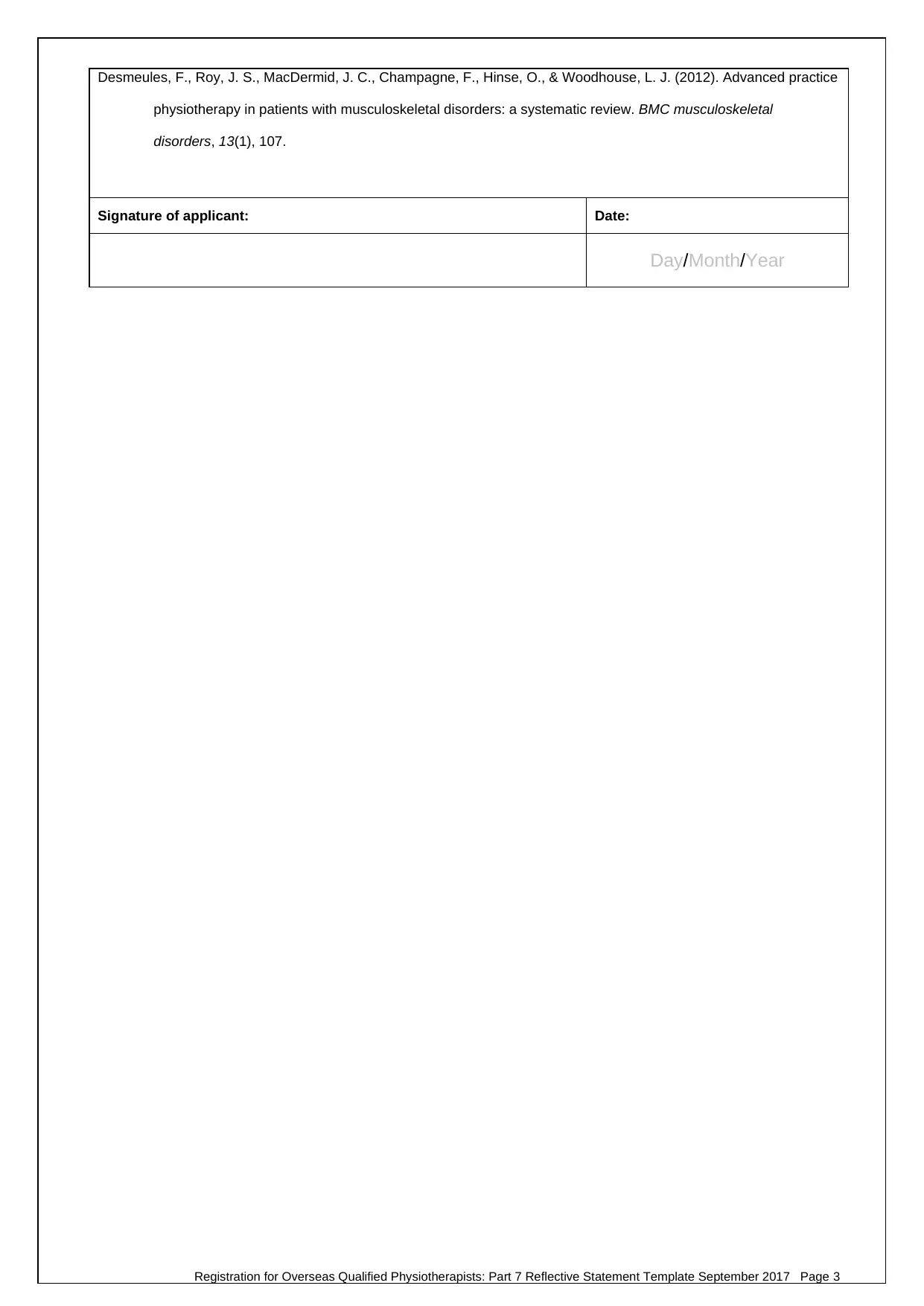Reflective Statement: Application for Physiotherapy Registration
VerifiedAdded on 2020/05/28
|3
|1455
|666
Practical Assignment
AI Summary
This document is a reflective statement from a physiotherapy student, detailing their experience treating a patient, Mr. X, who suffered from arthritis and mental illness. The student describes the various professional measures taken, including assessment, pain management techniques like hot/cold therapy, temporary splints, assistive devices, and TENS/electrotherapy. The student also discusses the ethical dilemmas faced, such as the patient's initial attack on staff and the student's illness, and how these issues were resolved. The reflection highlights the student's learning in applying various therapies, enhancing communication skills, and understanding AHPRA regulations. The student concludes that the experience positively influenced their practice by increasing confidence, improving treatment efficiency, and promoting proactive measures to prevent future ethical issues.

OUT THIS APPLI
P INF
REFLECTIVE STATEMENTS
Reflection allows you to critically think about what you have learnt. Reflective statements show how you intend to
implement or integrate new learning into your practice. Conversely you may reflect on why an activity was not
useful and has not been incorporated into your practice.
Examples of reflective practice you may choose to write about include:
Learning from managing a particularly complex
patient
Learning from a particular working environment
e.g. an inter-professional setting, or your first
evening on-call;
The evidence base for selecting a particular clinical
treatment;
How you accommodated a person’s cultural needs
in your practice;
How you resolved an ethical dilemma;
Issues when establishing a new protocol;
Researching information to enhance service
delivery;
A conference or course attended.
Please provide all reflective statements on this template. Reflective statements provided in other formats will not
be accepted. Adjust the relevant boxes to fit the content you insert.
Note: Please think carefully about the information you are including in your reflective statements. The
Physiotherapy Board does not request information about identifiable individuals such as patients or colleagues as
such information may constitute a breach of professional standards and ethics. You are advised to exercise
sound ethical judgment when deciding which information to include – consider how relevant the information is to
the point you are trying to make.
Reflective statements should be focused on you as a physiotherapist and what you have learnt, rather than the
patients or others involved in your learning.
Name of applicant:
Date of activity:
Name of activity:
Provider:
Learning category (if
appropriate):
Work based Professional activity
Formal education Self-directed learning
What did you do?
As a physiotherapist I had been visited by a patient, Mr. X who was suffering from severe pain and stiffness in
joints and muscles due to arthritis. In order to cure him completely I had taken the following professional
measures:
1. Firstly, after thoroughly assessing his condition I gave him a brief understanding of his issues in order to
help him to manage the pain.
2. Secondly, I suggested him hot and cold therapy to ease joint pain and stiffness. The mentioned therapy
includes ice packs to soothe swollen joints and heat packs to relax tired and tensed muscles
3. Since no initial improvement was noticed, I recommended him temporary splints to reduce the pain and
Registration for Overseas Qualified Physiotherapists: Part 7 Reflective Statement Template September 2017 Page 1
Applica
tion for
REGISTRATION APPLICATION Part 7: REFLECTIVE STATEMENT
P INF
REFLECTIVE STATEMENTS
Reflection allows you to critically think about what you have learnt. Reflective statements show how you intend to
implement or integrate new learning into your practice. Conversely you may reflect on why an activity was not
useful and has not been incorporated into your practice.
Examples of reflective practice you may choose to write about include:
Learning from managing a particularly complex
patient
Learning from a particular working environment
e.g. an inter-professional setting, or your first
evening on-call;
The evidence base for selecting a particular clinical
treatment;
How you accommodated a person’s cultural needs
in your practice;
How you resolved an ethical dilemma;
Issues when establishing a new protocol;
Researching information to enhance service
delivery;
A conference or course attended.
Please provide all reflective statements on this template. Reflective statements provided in other formats will not
be accepted. Adjust the relevant boxes to fit the content you insert.
Note: Please think carefully about the information you are including in your reflective statements. The
Physiotherapy Board does not request information about identifiable individuals such as patients or colleagues as
such information may constitute a breach of professional standards and ethics. You are advised to exercise
sound ethical judgment when deciding which information to include – consider how relevant the information is to
the point you are trying to make.
Reflective statements should be focused on you as a physiotherapist and what you have learnt, rather than the
patients or others involved in your learning.
Name of applicant:
Date of activity:
Name of activity:
Provider:
Learning category (if
appropriate):
Work based Professional activity
Formal education Self-directed learning
What did you do?
As a physiotherapist I had been visited by a patient, Mr. X who was suffering from severe pain and stiffness in
joints and muscles due to arthritis. In order to cure him completely I had taken the following professional
measures:
1. Firstly, after thoroughly assessing his condition I gave him a brief understanding of his issues in order to
help him to manage the pain.
2. Secondly, I suggested him hot and cold therapy to ease joint pain and stiffness. The mentioned therapy
includes ice packs to soothe swollen joints and heat packs to relax tired and tensed muscles
3. Since no initial improvement was noticed, I recommended him temporary splints to reduce the pain and
Registration for Overseas Qualified Physiotherapists: Part 7 Reflective Statement Template September 2017 Page 1
Applica
tion for
REGISTRATION APPLICATION Part 7: REFLECTIVE STATEMENT
Paraphrase This Document
Need a fresh take? Get an instant paraphrase of this document with our AI Paraphraser

swell in his joints.
4. I also suggested him to use walker as an assistive device after showing him how to use the device
properly.
5. When no improvement in the service user’s health was noticed even after two weeks due to his
reluctance to regular exercise at home, I recommended Transcutaneous electric Nerve Stimulation
(TENS) since he was suffering from immense pain (Desmeules, 2012).
6. I also performed electrotherapy on Mr. X to reduce the pain and stimulate the healing process.
7. In addition to that I educated him about the positive impact of exercise on his health and motivated him to
perform regular exercise at home.
8. Finally when the patient showed enough improvement, I motivated and suggested him not to stop
exercising, stretching and hydrotherapy, since it is really important for an Arthritis patient to stay active.
One of the major ethical dilemmas faced by me was when Mr. X, who was suffering from mental illness along
with Arthritis, initially attacked one of my staffs who was teaching him splint. Another ethical issue arises
when I got ill and was unable provide him with the necessary treatment. These issues were solved by me by
the following methods.
1. I held a psychological session for Mr. X, where I with the help of a psychologist educated him about the
whole physiotherapy treatment and made him understood that it was the staff’s duty to teach him the
exercises and that will eventually help Mr. X to get cured. No farther harm was reported after the
psychological session.
2. For the second ethical dilemma, I approached the higher authority for that day, Mr. X was treated by
another practitioner.
What did you learn?
During the whole process of training Mr. X, I faced several challenges and eventually solved them, which in turn, helped
me to learn several professional and ethical skills to cope up with adverse situation that are often faced by
physiotherapists while treating patients.
1. Being new to this profession, I had no experience of treating patients with the help of TENS and electrotherapy.
While training Mr. X I got practical knowledge, which enhanced my professional skills.
2. My second learning was that, a physiotherapist should posses certain psychological and verbal communication
skills to both motivate and manipulate the patient. Since Mr. X was initially reluctant to perform the exercises
given to him at home, proper motivation and education encouraged him and as a result he showed
improvement. Besides that, I also learned that to efficiently treat patients with psychological illness, like Mr. X,
verbal and motivational skills are necessary.
3. Finally I become aware of Australian Health Practitioner Regulation Agency (AHPRA), which helped me to deal
with the professional and ethical issues. According to ARPHA, patients care is the primary responsibility for a
physiotherapist (Crane & Delany, 2013). Hence, I did not stop Mr. X treatment and provided him the guidance
of another physiotherapist, during the period of my illness. Apart from this, I also learned from the regulations
of AHPRA which are associated with Effective communication and Health Care of Patients.
How did this activity affirm or influence your practice?
The whole activity has imposed a positive impact on my career as a physiotherapist, since it helped me to learn new
therapies and methods that will positively influence my future practice. Considering the fact that I had to deal with
several challenges while treating Mr. X, the whole process of facing the challenges and eventually coming out of the
adverse situation, have increased my confidence level. Since I have learned usage of TENS and electrotherapy from
this activity, I will be able to implement these treatments to my future patients with more efficiency. Moreover, since I
have already experienced an ethical issue where one of my staff has gone through violation, I will make sure that this
incident does not arise in future by educating the patients about the duty of the staffs prior to the initiation of the
treatment.
Reference List:
Crane, J., & Delany, C. (2013). Physiotherapists in emergency departments: responsibilities, accountability and
education. Physiotherapy, 99(2), 95-100.
Registration for Overseas Qualified Physiotherapists: Part 7 Reflective Statement Template September 2017 Page 2
4. I also suggested him to use walker as an assistive device after showing him how to use the device
properly.
5. When no improvement in the service user’s health was noticed even after two weeks due to his
reluctance to regular exercise at home, I recommended Transcutaneous electric Nerve Stimulation
(TENS) since he was suffering from immense pain (Desmeules, 2012).
6. I also performed electrotherapy on Mr. X to reduce the pain and stimulate the healing process.
7. In addition to that I educated him about the positive impact of exercise on his health and motivated him to
perform regular exercise at home.
8. Finally when the patient showed enough improvement, I motivated and suggested him not to stop
exercising, stretching and hydrotherapy, since it is really important for an Arthritis patient to stay active.
One of the major ethical dilemmas faced by me was when Mr. X, who was suffering from mental illness along
with Arthritis, initially attacked one of my staffs who was teaching him splint. Another ethical issue arises
when I got ill and was unable provide him with the necessary treatment. These issues were solved by me by
the following methods.
1. I held a psychological session for Mr. X, where I with the help of a psychologist educated him about the
whole physiotherapy treatment and made him understood that it was the staff’s duty to teach him the
exercises and that will eventually help Mr. X to get cured. No farther harm was reported after the
psychological session.
2. For the second ethical dilemma, I approached the higher authority for that day, Mr. X was treated by
another practitioner.
What did you learn?
During the whole process of training Mr. X, I faced several challenges and eventually solved them, which in turn, helped
me to learn several professional and ethical skills to cope up with adverse situation that are often faced by
physiotherapists while treating patients.
1. Being new to this profession, I had no experience of treating patients with the help of TENS and electrotherapy.
While training Mr. X I got practical knowledge, which enhanced my professional skills.
2. My second learning was that, a physiotherapist should posses certain psychological and verbal communication
skills to both motivate and manipulate the patient. Since Mr. X was initially reluctant to perform the exercises
given to him at home, proper motivation and education encouraged him and as a result he showed
improvement. Besides that, I also learned that to efficiently treat patients with psychological illness, like Mr. X,
verbal and motivational skills are necessary.
3. Finally I become aware of Australian Health Practitioner Regulation Agency (AHPRA), which helped me to deal
with the professional and ethical issues. According to ARPHA, patients care is the primary responsibility for a
physiotherapist (Crane & Delany, 2013). Hence, I did not stop Mr. X treatment and provided him the guidance
of another physiotherapist, during the period of my illness. Apart from this, I also learned from the regulations
of AHPRA which are associated with Effective communication and Health Care of Patients.
How did this activity affirm or influence your practice?
The whole activity has imposed a positive impact on my career as a physiotherapist, since it helped me to learn new
therapies and methods that will positively influence my future practice. Considering the fact that I had to deal with
several challenges while treating Mr. X, the whole process of facing the challenges and eventually coming out of the
adverse situation, have increased my confidence level. Since I have learned usage of TENS and electrotherapy from
this activity, I will be able to implement these treatments to my future patients with more efficiency. Moreover, since I
have already experienced an ethical issue where one of my staff has gone through violation, I will make sure that this
incident does not arise in future by educating the patients about the duty of the staffs prior to the initiation of the
treatment.
Reference List:
Crane, J., & Delany, C. (2013). Physiotherapists in emergency departments: responsibilities, accountability and
education. Physiotherapy, 99(2), 95-100.
Registration for Overseas Qualified Physiotherapists: Part 7 Reflective Statement Template September 2017 Page 2

Desmeules, F., Roy, J. S., MacDermid, J. C., Champagne, F., Hinse, O., & Woodhouse, L. J. (2012). Advanced practice
physiotherapy in patients with musculoskeletal disorders: a systematic review. BMC musculoskeletal
disorders, 13(1), 107.
Signature of applicant: Date:
Day/Month/Year
Registration for Overseas Qualified Physiotherapists: Part 7 Reflective Statement Template September 2017 Page 3
physiotherapy in patients with musculoskeletal disorders: a systematic review. BMC musculoskeletal
disorders, 13(1), 107.
Signature of applicant: Date:
Day/Month/Year
Registration for Overseas Qualified Physiotherapists: Part 7 Reflective Statement Template September 2017 Page 3
⊘ This is a preview!⊘
Do you want full access?
Subscribe today to unlock all pages.

Trusted by 1+ million students worldwide
1 out of 3
Related Documents
Your All-in-One AI-Powered Toolkit for Academic Success.
+13062052269
info@desklib.com
Available 24*7 on WhatsApp / Email
![[object Object]](/_next/static/media/star-bottom.7253800d.svg)
Unlock your academic potential
Copyright © 2020–2025 A2Z Services. All Rights Reserved. Developed and managed by ZUCOL.





